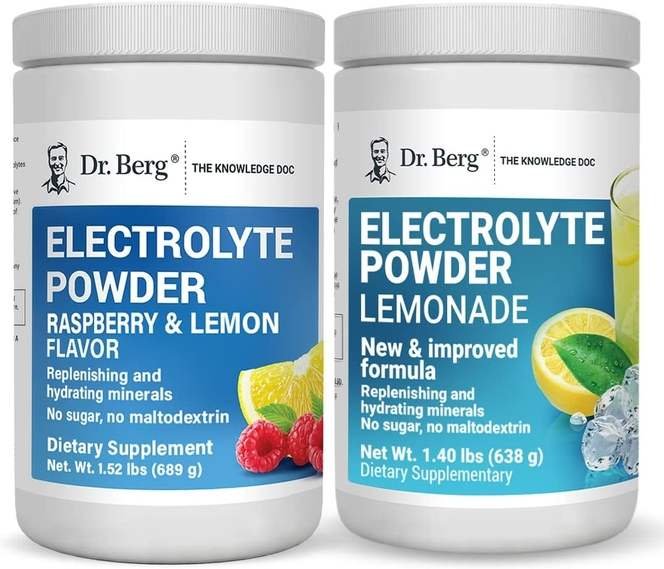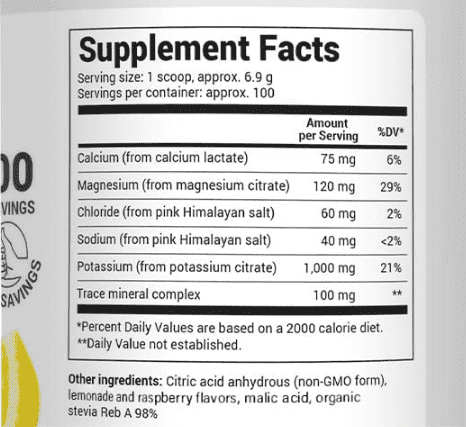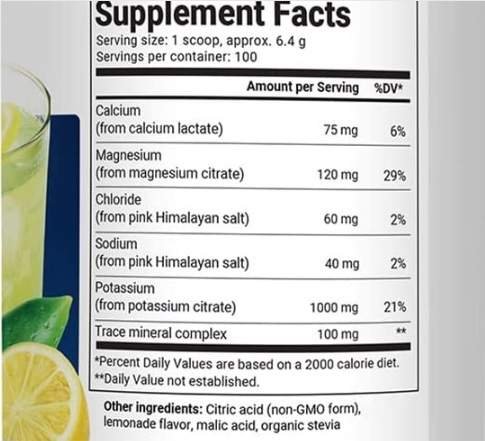Analysis Of Dr Berg Electrolyte Powder Ingredients: Here’s what you need to know

In this article I am going to analyze in detail the ingredients found in Dr Berg’s Electrolyte Powder. Although, we have reviewed Dr Berg Electrolyte powder in a previous article, we haven’t gone into much detail about it’s ingredients.
In this article, we are going to take a deep dive into Dr Berg electrolyte powder ingredients and uncover their potential benefits.
By doing so, we can better comprehend why this powder has become increasingly popular among health-conscious individuals.

Dr Berg Electrolyte Powder Ingredients
Before we analyze Dr Berg Electrolyte Powder Ingredients, here’s a table that compares the two versions of Dr. Berg’s Electrolytes Powder:
| Raspberry Lemon | Lemonade | |
|---|---|---|
| Calcium (from Calcium Lactate) | 75mg | 75mg |
| Magnesium (magnesium citrate) | 120mg | 120mg |
| Chloride (from pink Himalayan salt) | 60mg | 60mg |
| Sodium (from pink Himalayan salt) | 40mg | 40mg |
| Potassium (from Potassium Citrate) | 1000mg | 1000mg |
| Trace Mineral Complex | 100mg | 100mg |
| Citric Acid Anhydrous (Non-GMO) | ✔️ | ✔️ |
| Flavor | Raspberry Lemon | Lemonade |
| Malic Acid | ✔️ | ✔️ |
| Organic Stevia | Reb-A 98% | Normal |
As you can see from the chart above, the only difference between the two versions is the flavor and the Stevia.
More particularly, the Lemonade flavor version of Dr. Berg’s electrolyte powder does write that it is Reb-A 98%. But, what does Reb-A 98% means anyway? You’ll find more about it down the road.


Analysis
Now, that we took that out of the way, let’s take a closer look at each ingredient in Dr. Berg’s Electrolytes Powder and what it does:
When you sit too much every day, you disturb your body’s natural functions, slow down your metabolism, and impair blood sugar regulation. Your circulation and heart health suffer, and your muscles and bones weaken. Mentally, you face a higher risk of anxiety and depression.
To counteract these effects, incorporate standing breaks, desk exercises, or walking meetings. Short, frequent movements can make a big impact.
Small changes like these can alleviate many issues associated with prolonged sitting. Learn how simple habits can greatly enhance your overall well-being.
Prolonged Sitting Disrupts Body Functions
Sitting for long periods can mess up your body’s natural functions. It can cause problems with your metabolism, blood sugar levels, and blood flow. When you sit too much, your body’s metabolism slows down. This means you burn fewer calories, which can lead to weight gain and obesity.
Sitting also makes it harder for your muscles to use blood sugar properly. This can increase insulin resistance and raise the risk of type 2 diabetes.
Your heart health can suffer too. Blood can pool in your legs, leading to poor artery function and a higher risk of heart disease.
It can also increase your blood pressure and cholesterol levels, which are bad for your heart. Poor blood flow can cause varicose veins and, in severe cases, deep vein thrombosis (DVT).
Sitting too long affects your muscles and bones as well. Bad posture can strain your back, neck, and shoulders, causing pain and possibly leading to problems with your spinal discs. Not moving enough can also weaken your bones, raising the risk of osteoporosis.
☝️ The human body was designed to move, jump, run, and do strength activities. It is not supposed to sit all day.
Over millions of years, our bodies have evolved to be very active and capable of many physical activities, like walking, running, climbing, and lifting. Our bones, muscles, heart, and brain are all made to work best when we move and exercise.
For most of human history, people had to be active to survive. They hunted animals, gathered food, farmed, and did other hard tasks every day. Sitting still for long times is something new for humans. This change happened because of machines, technology, and how work and free time have changed.
Now, many people spend too much time sitting, whether at school, work, or home, which can be bad for our health. Regular movement and exercise are key to staying healthy and avoiding these problems.
Excessive Sitting and Mental Health Risks
Sitting too much doesn’t just hurt your body; it can also affect your mind. Spending a lot of time sitting can increase the risk of anxiety and depression. The more you sit, the higher your chances of feeling anxious or depressed.
Studies from the Semel Institute for Neuroscience and Human Behavior at the University of California Los Angeles (UCLA) show that sitting a lot can affect the brain. Through MRI scans, researchers found that the more hours people spent sitting each day, the thinner the tissue in their medial temporal lobe (MTL), which includes the hippocampus. The hippocampus is largely responsible for storing and accessing memory. This means fewer new brain cells are made, which can hurt memory over time.
Interestingly, regular exercise alone doesn’t fix the problem. Even if you exercise a lot, sitting for long periods still poses a risk. Taking short, frequent breaks can help.
Research shows that people who stand up or move around every 30 minutes have about half the risk of anxiety and depression compared to those who don’t take breaks. [1]
How To Break the Cycle: Actionable Solutions for Everyone
Whether you’re an office worker, a gamer, or a driver, breaking the cycle of prolonged sitting is vital for your health. Begin by integrating small changes such as using a standing desk.
Regular breaks to move around are also essential. Incorporating light exercises into your routine can significantly reduce the risks associated with excessive sitting.
These adjustments make a noticeable difference, promoting better overall health.
Office Workers
Office workers can break the habit of sitting all day by adding regular movement and activity into their daily routines. Start by taking short breaks every hour to stand up, stretch, or take a quick walk. Setting reminders on your computer or phone can help you remember to move.
Here are some practical tips:
- Use a standing desk: You can switch between sitting and standing, which reduces the time you spend in one position.
- Walking meetings: Instead of sitting in a conference room, walk during meetings. Walking can help you think better and stay active.
- Desk exercises: Simple exercises like leg raises, shoulder rolls, or desk push-ups can be done at your desk.
Creating a more active work environment helps your physical health and also boosts productivity and mental well-being. Employers can help by providing resources like standing desks or organizing fitness classes. Also, using fitness trackers can help you monitor your activity and meet your movement goals.
Gamers
Gamers need to move more to stay healthy, just like office workers. Sitting for a long time can cause health problems like deep vein thrombosis, high blood sugar, high cholesterol, and increased body fat.
Here are some simple ways to stay healthy:
- Take frequent breaks: Try to get up and move for 5-10 minutes every hour. You could walk to the kitchen for a drink.
- Exercise daily: Spend at least 30 minutes a day exercising. You can cycle, do calisthenics, or have a short workout to help your body.
- Use a standing desk: Switch between sitting and standing during the day to avoid being still for too long.
Make sure your workstation is set up right. Raise your monitor to eye level and use an external keyboard to help with good posture. This can stop you from hunching over.
Building healthy habits is important. Make moving a regular part of your day. Set reminders to take breaks and focus on your physical health.
Balancing small activities throughout the day is key for your long-term health and well-being.
Drivers
As a truck driver, it’s important to break the habit of sitting for long hours. Sitting for too long can cause health problems like obesity, heart disease, and muscle pain. But, there are simple steps you can take to stay healthy.
First, use your breaks wisely. Take a 10-30 minute walk or go to a nearby park to get some exercise and fresh air. Even a little bit of movement can help. Set a timer to remind you to move around every 30-60 minutes. Standing up helps your blood flow, gives you more energy, and makes you feel better.
Here are some easy tips:
- Add short activities: Even a 5-10 minute walk can help.
- Choose good distractions: During breaks, take a walk or stretch instead of looking at your phone.
- Plan your day: Make a to-do list at the end of each day to stay focused and organized.
Micro-movements: List of simple exercises that can be done at one’s desk throughout the day.
Counteract the negative effects of prolonged sitting by incorporating micro-movements into your daily routine.
Simple exercises like stretches, strength exercises, cardiovascular activities, and breathing exercises can be done right at your desk.
Explore these practical and effective options to stay active and healthy throughout the workday.
Stretches and Flexibility Exercises
Ever wondered how you can keep your body flexible and reduce stiffness right at your desk? Sitting for long periods can be hard on your body, but doing simple stretches and flexibility exercises can help.
Here are a few easy movements you can do without leaving your workspace:
- Neck Rolls: Lean your head forward, then rotate it in a circle for 10-15 seconds. Switch direction and repeat. This helps reduce tension in your neck and shoulders.
- Lower Back Stretch: Stand up and gently reach for your toes. Hold this position for 10-30 seconds. This stretch can help ease stress in your lower back and improve flexibility.
- Spinal Twist: Sit sideways in your chair and hold the backrest with both hands. Twist your body towards the back of the chair and hold for 10 seconds. Then switch sides. This exercise is good for your spine and can help reduce back pain.
These simple exercises can make a big difference in how your body feels during the day.
Strength Exercises
Adding strength exercises to your daily routine can be easy and helpful, even while seated at your desk. These small movements can help you fight the bad effects of sitting too long, like weak muscles and poor blood flow.
Here are some simple exercises you can do without leaving your workspace:
- Seated Core Bracing: Sit up straight, tilt your hips a bit forward, and pull your belly button in. Hold for 10-15 seconds, relax, and repeat 5 times.
- Marching Core: Sit on the edge of your chair, tighten your stomach muscles, and lean back a little while keeping your back straight. For an extra challenge, lift one foot at a time. Hold for 10-15 seconds, relax, and repeat 5 times.
- Shoulder Blade Pinches: Sit up straight and pinch your shoulder blades together like you’re squeezing a pencil between them. Relax and repeat 20 times.
These exercises help keep your muscles strong and improve your posture and overall health. By adding these simple moves to your day, you can fight the harmful effects of sitting too much. Remember, small actions can lead to big changes.
Cardiovascular Exercises
Improving your heart health while at your desk is possible with simple movements. These exercises can fit into your daily routine and help reduce the bad effects of sitting too long.
Here are three easy exercises you can try:
- Jogging in place: Stand up and jog in one spot for 1-2 minutes. This quick exercise raises your heart rate and can be done without disturbing your workspace.
- Desk push-ups: Place your hands on the edge of your desk and do push-ups while keeping your body straight. Aim for 10-15 repetitions to work your upper body and boost your heart rate.
- Chair dips: Sit on the edge of your chair, grip the seat, extend your legs, and lower your body towards the floor. Push back up and repeat 5-10 times. This targets your triceps and improves blood flow.
Adding these simple exercises to your workday can improve your health. They’re quick, effective, and need no special equipment. This makes it easy to stay active throughout the day.
Breathing Exercises
To reduce stress and improve focus while at your desk, try simple breathing exercises like the 4-7-8 technique. This exercise involves breathing in for 4 counts, holding the breath for 7 counts, and then exhaling for 8 counts. It helps calm your mind and boost concentration without leaving your chair.
Breathing exercises can help manage the bad effects of sitting for a long time. When you sit for too long, your body’s processes slow down. You may also have less blood flow and more muscle tension. Breathing exercises can help by making you relax and getting more oxygen into your body.
Another easy technique is diaphragmatic breathing. Sit up straight, put one hand on your chest and the other on your belly. Breathe deeply through your nose. Make sure your belly rises more than your chest. This helps your diaphragm work better, reduces muscle tension, and improves posture.
These small movements are easy to add to your daily routine. They can make a big difference in how you feel during the day. Take a few moments each hour to practice these exercises and notice the improvement in your overall well-being.
Making Movement a Habit: practical strategies to integrate movement into your day
Creating new habits takes time, but with some planning, you can add more movement to your daily routine. Start with small, easy goals and build up slowly. Here’s a simple schedule to get you started:
| Time | Activity |
|---|---|
| 9:00 AM | Start work, sitting |
| 10:30 AM | Stand up and stretch for 5 minutes |
| 12:00 PM | Lunch break – eat standing or take a walk |
| 2:00 PM | Switch to standing desk or desk exercises |
| 3:30 PM | Take a quick walking break |
| 5:00 PM | End of workday |
Technology can help remind you to move. Smartwatches and fitness trackers often alert you when you’ve been sitting too long. There are also apps that send reminders to take movement breaks.
Small changes can make a big difference. Stand while talking on the phone, take the stairs instead of the elevator, or walk to a colleague’s desk instead of emailing. Add these steps gradually, and moving more will become a natural part of your day. This approach not only breaks up sitting time but also improves your overall well-being.
Recent studies on the dangers of sitting or the benefits of movement
Adding movement to your daily routine is important. Recent studies show that sitting too much can be harmful, and being active has many benefits.
A study from the University of California, San Diego found that sitting for more than 11 hours a day raises the risk of death by 57%, compared to sitting less than 9.5 hours. Even regular exercise can’t fully remove these risks.
Another study in the British Journal of Sports Medicine says that just 22 minutes of exercise each day can help reduce the bad health effects of sitting too much. Each extra 10 minutes of activity per day lowers the risk of death by 15-35%.
The Mayo Clinic’s research shows that sitting for long periods is linked to metabolic syndrome. This includes obesity, high blood pressure, high blood sugar, and bad cholesterol levels. These problems increase the chances of heart disease, stroke, and type 2 diabetes.
A study in JAMA Open Network found that people who sit most of the day at work have a 16% higher risk of death from all causes and a 34% higher risk of heart disease. Adding just 15-30 minutes of daily physical activity can help reduce these risks.
Conclusion
Make movement a priority in your daily routine to counteract the effects of prolonged sitting. Integrate micro-movements like desk exercises, take regular breaks to stand, stretch, or walk, and consider using standing desks. These small changes can enhance your metabolism, boost circulation, and improve mental well-being.
Take action today: start incorporating these tips into your routine for better health and quality of life.
How Much Do You Sit? – Interactive Quiz
Calcium (from Calcium Lactate)
Calcium is an essential mineral that plays a crucial role in maintaining strong bones and teeth. It also helps in proper muscle function, nerve transmission, and supports cardiovascular health.
Calcium lactate is a salt form of calcium that is commonly used in dietary supplements and food products. [1]
Calcium lactate is made using a process that involves the “reaction” between lactic acid and calcium carbonate. This “reaction” results in the formation of calcium lactate, which is then purified and used as a source of calcium in various products. [1]
The advantage of using calcium lactate is that it provides a more bioavailable form of calcium – which means it is absorbed better in the body. Calcium lactate is generally well-absorbed in the digestive system, making it an effective source of calcium for the body to use. [2]
It’s important to say that calcium lactate is just one of several forms of calcium that can be used in supplements. Other common forms include calcium carbonate, calcium citrate, and calcium gluconate, among others.
Each form has its own characteristics, including differences in bioavailability, solubility, and suitability for specific dietary needs.
Magnesium (magnesium citrate)
Magnesium is another important mineral that supports various bodily functions. It helps with muscle and nerve function, promotes energy production, regulates blood pressure, and contributes to bone health.
Magnesium citrate is a commonly used form of magnesium in dietary supplements. While it does offer several benefits, it is important to consider its characteristics and potential drawbacks compared to other forms of magnesium.
Related: Magnesium Breakthrough Review: Is This The Best Magnesium Supplement In The Market?
Magnesium citrate has relatively high bioavailability, meaning it is readily absorbed in the gastrointestinal tract and can effectively increase magnesium levels in the body. [3]
However, it is worth mentioning that magnesium citrate also has a well-known laxative effect. This can be beneficial if you have constipation. But, if you don’t want the laxative effect, this can be a disadvantage.
Other forms of magnesium, such as magnesium glycinate or magnesium oxide, may not have the same laxative effect.
Moreover, when comparing magnesium citrate to other forms, it is important to consider the specific needs and preferences of each individual.
For instance, magnesium glycinate is often favored for its potential to provide relaxation and support sleep due to its calming properties.
On the other hand, magnesium oxide is known for its high elemental magnesium content, making it a cost-effective option, but it may have lower bioavailability compared to magnesium citrate.
Related: Perpetua Life Magnesium Gummies Review
Chloride (from pink Himalayan salt)
Chloride is an electrolyte that works in conjunction with sodium and potassium to regulate fluid levels, support nerve function, and assist in muscle contraction.
Dr. Berg’s electrolyte powder mentions that its chloride content derives from “pink Himalayan salt“. Pink Himalayan salt is a type of rock salt that is mined from the Khewra Salt Mine in the Punjab region of Pakistan.

Now, the reason for specifying the source of chloride as pink Himalayan salt is primarily for transparency and marketing purposes (in my opinion).
Providing information about the origin of the ingredient gives you a sense of trustworthiness and of better quality.
Talking about quality, pink Himalayan salt is often praised for its natural composition and lack of additives or chemical processing. It is considered to be a more natural and less processed option compared to some commercially available table salts.
However, when it comes to the chloride content, the source of the chloride, whether it is from pink Himalayan salt or another source, does not significantly affect the overall quality or benefits of the electrolyte powder.
So, while the mention of chloride from pink Himalayan salt provides insight into the origin of the ingredient, that doesn’t mean that it is inherently a better or superior quality option.
The focus should primarily be on the overall electrolyte balance and composition provided by the product, rather than on the specific source of chloride.
Related: 10 Reasons To Have A Himalayan Salt Lamp In Every Room Of Your Home
Sodium (from pink Himalayan salt)
Sodium is a key electrolyte that plays a vital role in maintaining fluid balance, supporting nerve function, and aiding in muscle contraction. It is an essential nutrient for overall body function.
Just like above, sodium content in Dr. Berg’s electrolyte powder derives from Pink Himalayan salt which is considered more pure than other forms of salt – without necessary mean that it is better form of sodium that other sources.
Potassium (from Potassium Citrate)
Potassium is an electrolyte that helps regulate fluid balance, supports proper nerve function, and assists in muscle contraction. It is particularly important for maintaining a healthy heart rhythm. Along with Sodium, they are praised as the most important electrolytes.
The potassium component in Dr. Berg’s Electrolytes Powder is derived from the compound known as potassium citrate. Potassium citrate is a type of salt formed by combining potassium with citric acid. [4]
The choice of using potassium citrate as the source of potassium in the electrolyte powder is probably due to its solubility, bioavailability, and compatibility with other ingredients.
Potassium citrate is commonly used in dietary supplements and food products due to its ability to provide a readily available and easily absorbable form of potassium. [5]
Potassium citrate is a well-studied and commonly used form of potassium supplementation. It is generally recognized as safe and effective for meeting potassium needs in the body.
Note that the source of potassium, whether it is potassium citrate or another form, does not significantly affect the quality or benefits of the electrolyte powder – in my opinion. The focus should be on ensuring an adequate intake of potassium, rather than the specific source.
Trace Mineral Complex
This complex includes a blend of various trace minerals, which are essential nutrients needed in small amounts by the body. These minerals help support overall health and contribute to various physiological processes.
The term “complex” – without mentioning exactly what the complex includes, makes me thing that it is a ready made ingredient that it is added into the mix to enhance the powder’s properties.
Citric Acid Anhydrous (Non-GMO)
Citric acid is a natural acid found in citrus fruits. In this powdered form, it acts as a flavoring agent and also helps to preserve freshness, and regulate acidity.
The term “anhydrous” means that the citric acid is in a dry, powdered form without any water content.
an·hy·drous > : free from water and especially water of crystallization. Etymology > Greek anydros, from a- + hydōr (water).
Merriam-Webster
Anhydrous citric acid is created by removing the water molecules from the citric acid crystals, resulting in a fine, white powder. [6]
Anhydrous citric acid is a commonly used and accepted form of citric acid, offering ease of use, stability, and consistent performance in various applications.
The specification of “Non-GMO” on the label means that the citric acid used in the product comes from non-genetically modified organisms.
Genetically modified organisms (GMOs) are organisms whose genetic material has been altered through genetic engineering techniques. [7]
While the majority of citric acid in the market is not derived from GMO sources, the specification of “Non-GMO” provides reassurance to individuals who prefer to avoid GMO ingredients in their dietary choices.
Lemonade & Raspberry flavors
These are natural flavors added to enhance the taste of the electrolyte powder, giving it a refreshing lemonade and raspberry flavor.
These flavors are created through a process that extracts the desired aromatic and flavorful compounds from the natural sources.
To make natural lemonade flavor, for example, the flavor compounds found in real lemons are extracted. This can involve methods like cold pressing or steam distillation to obtain the essential oils and aromatic compounds that give lemons their distinct taste and aroma.
These natural lemon flavor components are then carefully blended to create a flavor that closely resembles the taste of fresh lemonade.
Similarly, for natural raspberry flavor, the flavor compounds responsible for the characteristic taste and aroma of raspberries are extracted from real raspberries. This can involve processes like maceration or solvent extraction, where the desired raspberry flavor compounds are carefully isolated and concentrated.
The use of natural flavors allows food and beverage manufacturers to provide a desirable taste without relying solely on artificial or synthetic additives.
Malic Acid
Malic acid is a naturally occurring organic acid found in various fruits. It adds a tart flavor to the powder and also contributes to the overall taste experience. It is a naturally occurring acid found in various fruits, including apples, and contributes to their tart taste.
Malic acid is involved in energy production in the body and is a key component of the Krebs cycle, which is responsible for generating energy from food. [8]
Also, Malic acid has been studied for its potential to support muscle function and recovery, as well as to promote oral health.
However, it’s important to note that malic acid, like any acid, should be consumed in moderation. Excessive consumption of acidic substances may potentially cause irritation or discomfort in individuals with sensitive stomachs or certain digestive conditions.
In Dr. Berg’s Electrolytes Powder, the addition of malic acid is mostly there for flavor enhancement – nothing more.
Organic Stevia (Reb-A 98%)
Stevia is a natural sweetener derived from the Stevia rebaudiana plant (known also as Candyleaf). It provides sweetness to the powder without adding calories, making it a popular alternative to sugar.

The Reb-A 98% that writes next to organic stevia is a way of measuring the purity or concentration of the sweet components in Stevia.
In this case, it means that the Organic Stevia used in Dr. Berg’s Electrolytes Powder is super pure and contains a high concentration of a specific sweet compound called Reb-A, which stands for Rebaudioside A.
Reb-A is the sweetest part of the Stevia leaf and has a sweet taste that can be up to 200 times sweeter than sugar. So, even though the Organic Stevia used in the powder is highly concentrated, only a little bit is needed to make things taste sweet.
Using Organic Stevia (Reb-A 98%) allows Dr. Berg’s Electrolytes Powder to have a sweet taste without adding extra calories or using artificial sweeteners.
Bottom Line
So there you have it. Our Analysis of Dr Berg Electrolyte powder ingredients. I hope by know you got a better understanding of what the ingredients label says.
Dr. Berg Electrolyte Powder has a bunch of cool ingredients that can be good for your body. It’s got calcium, magnesium, chloride, sodium, and potassium, which all help with important stuff like strong bones, muscle function, and maintaining balance in your body.
There’s also malic acid and organic stevia for flavor, which makes it taste super yummy.
